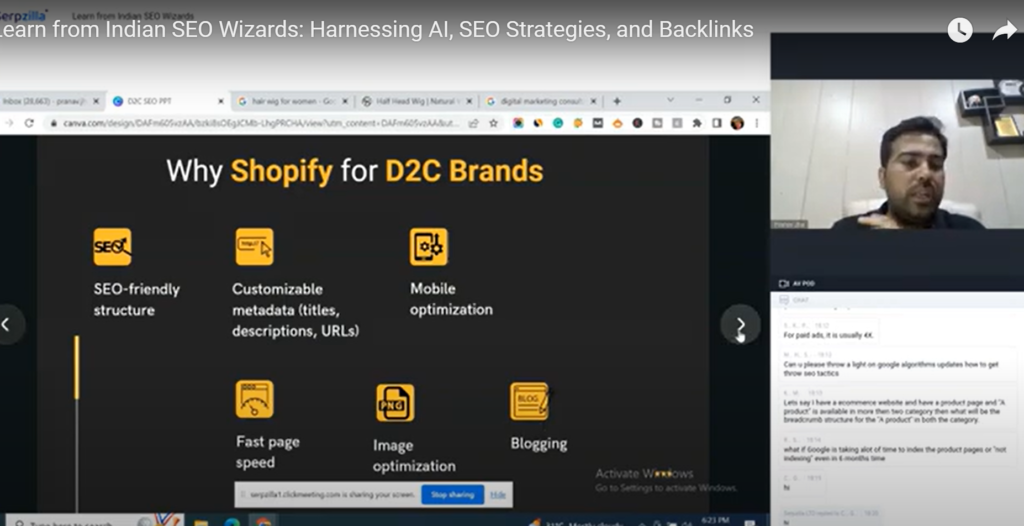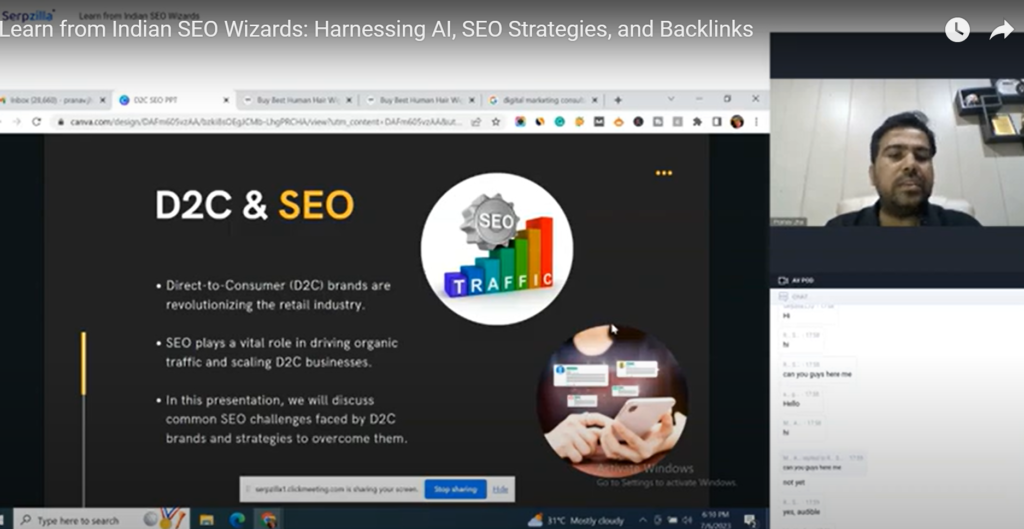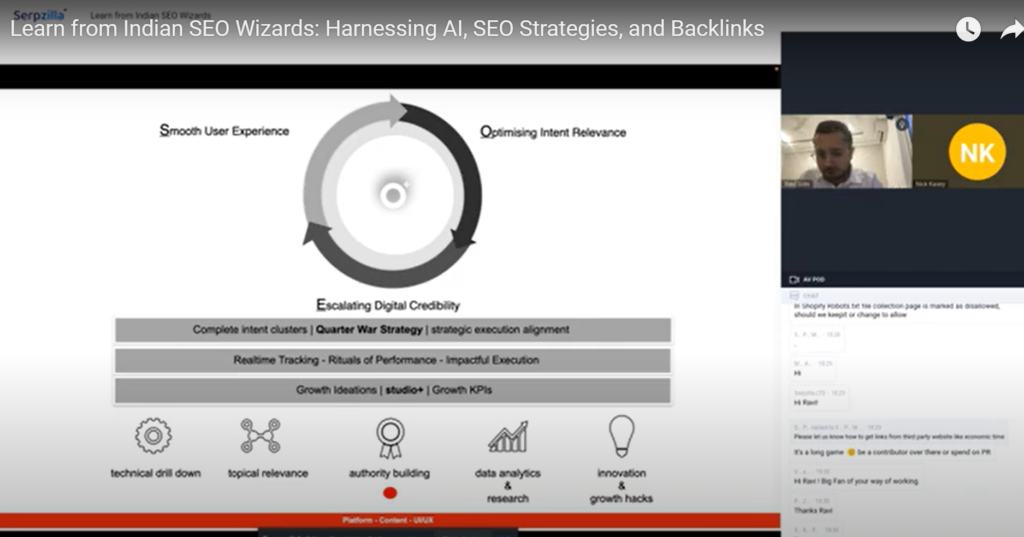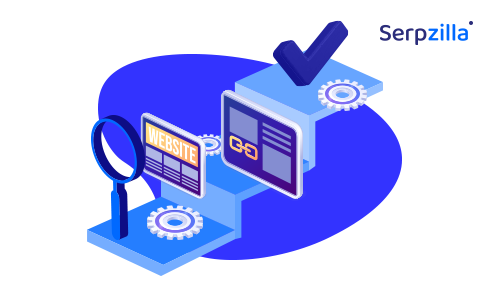Hello there, my name is Nick Kasey – Serpzilla Ambassador, and today we are continuing our recently started series of YouTube Videos about SEO tips, tricks and working strategies. It is a new format for us, but we decided to launch a YouTube channel due to the popular demand for video-based SEO knowledge. For those who prefer the text format, each of these videos is also available as a detailed article. Now, without further ado, let’s start.
Today’s session with Pranav Jha – Director at AP Web World, and Ravi Soni – Co-Founder of Obbserv & Opositive is dedicated to how SEO and link-building helps with large-scale sites in India. The Indian market is huge and full of local specifics and peculiarities, so it’s no surprise that SEO for India-oriented sites has its own flavor as well. Our experts today share invaluable insights and cool cases, as well as provide useful recommendations to SEO marketers in India.
SEO Trends Relevant for India in 2024
Our experts draw a pretty detailed picture of the SEO landscape that is characteristic of India. Here are some of the most prominent trends they name.
- Shift from Established Platforms to Custom-Built Platforms:
There is an ongoing major shift in the Indian e-commerce market, with businesses moving from using major platforms like Amazon and Flipkart to custom-built platforms such as WordPress, Shopify, and Magento. In India, there are several factors that drive this change. First, businesses want to have more control over the customer experience. Second, these platforms have more room to customize the online store and to better fit brand identity and customer needs.

2. Growth of Direct-to-Consumer (D2C) Brands:
Many D2C brands are gaining significant traction in India. Shows like Shark Tank India are highlighting D2C brands, which are successfully scaling their operations and attracting consumer attention. Our experts say that this media hype is one of the reasons why audiences switch from huge chains and brands to local D2C brands. However, D2C marketing has its own set of rules and a specific approach to SEO. Our experts name brands such as Paper Fry, Mama Earth, Babycoof.com, Boat, and Sleepy Owl as examples of successful D2C e-commerce businesses in India.

3. Preference for SEO-Friendly E-commerce Platforms:
D2C segment competition in India is huge, so brands prefer platforms that can boost their SEO efforts and minimize the time spent on SEO. For instance, Shopify, as it offers a SEO-friendly structure, which allows easy customization of collection and product pages. Something else factors in here: it’s budget constraints. Brands are choosing a platform depending on how much money they want to invest in marketing, and the difference can be very significant. Some are opting for more customized solutions like Magento or Laravel based on their specific requirements.
D2C SEO Specifics For India
Our experts draw attention to several factors that are highly relevant if you want to build a successful SEO strategy for an Indian digital market. Here are some of the key factors they name:
- Content is Made Key
Our experts say that for success, you need to build your SEO strategy around high-quality content. Create FAQs, reviews, and detailed product information. You should focus on making your content engaging, valid, useful and specific to your customer needs.
- Leveraging Local SEO
Most D2C brands are local brands to a certain extent. They either operate locally, have an offline business or target a specific geographic area. That is why your main focus if you are a D2C brand, should be on local SEO. Optimize local SEO through Google My Business listings, Google Maps, none-Google local directories. When link building, make sure you are obtaining enough links that share the same geolocation as you. It is important for driving foot traffic.
- High Quality Backlinks
As a D2C brand, it is important to carry out an extensive link building campaign. You can use such link building means as guest posting, collaborations with local influencers, localized PR. It will improve your website’s authority and reputation with your audience. It will also make your brand more visible.
- Accessibility
No matter if you are a small or a large D2C brand in India, you need to make your website and information as accessible as possible to reach larger audiences. Make sure you are mobile-friendly, considering that many of your users will not be tech-savvy. Your site needs to be made easy to navigate and simple to interact with. You should also make your pricing and product descriptions clear and easy to find. Avoid anything in your content that could be misleading for your customer.
Actionable Tips for SEO Marketers that Target India
Indian brands are often working on a budget when it comes to marketing. At the same time, they are experiencing tough competition. Here are some tips our experts give that could help you to allocate your SEO spendings correctly and achieve more with less.
Use Cutting-Edge SEO Tools
- Google Keywords Planner
A free tool offered by Google, its Keyword Planner is a very powerful instrument. You can use it to discover new keywords related to your business and Google searches associated with what you offer. You can also check the estimated volume of the searchesand the cost to target them using various Google Ads. This tool helps you to discover less-used and less-obvious but better-targeted keywords for your pay-per-click campaigns that may yield higher conversion rate.
- Ahrefs
An industry staple, this tool provides you with extensive analytic data about your SEO performance, link building efforts and keyword research. It is a toolkit that features several instruments: Site Explorer, Keywords Explorer, Content Explorer, and Rank Tracker. You can use it for profound SEO and backlink analysis both for your own website and that of your competitors. Competitor analysis helps you to pinpoint successful strategies your competition uses and avoid their mistakes.
- Semrush
An all-in-one marketing toolkit fit for marketers from all walks of SEO life. It offers tools for keyword research, site audits, backlink analysis, rank tracking, and competitive analysis. SEMrush also includes features for content marketing and social media management. It helps you come up with a vast array of keyword ideas, including long-tail keywords. Their Site Audit tool can help identify technical SEO issues that could affect your search rankings. Additionally, SEMrush’s competitive analysis tools enable marketers to uncover competitors’ strategies and find opportunities to outperform them.
Analytics and Data-Driven Decision-Making
When you plan and execute your SEO strategy in the Indian market, this is an important aspect. The market itself is huge, diverse, and competitive. It requires a serious depth of knowledge from you, and you will need to keep in mind an array of factors to make timely and correct decisions. This is why your decisions need to be very educated and very well grounded with extensive analysis and precisely gathered and processed data. You can use AI tools for this process. Our experts emphasize tracking every action on the website to understand user behavior and improve SEO strategy. Using analytics to measure the effectiveness of SEO efforts and make data-driven decisions is crucial for success.
Do not Expect Immediate Results
While some of your actions will have immediate results, they will be more like trends, not quantity and quality shifts. When planning a SEO campaign on the Indian market, expect your benefits to be long-term and your ROI not to me immediate. Our experts highlight the cost-effective SEO strategy compared to paid ads, although it requires patience and consistent effort. The long-term benefits of SEO, such as lower cost per acquisition and sustainable traffic growth, are significant advantages over short-term pay-for-click growth.
Specific Tips for Large-Scale Sites
Our experts had a few valuable pieces of advice for owners of large websites. First, they recommend focusing on comprehensive long-tail keywords and targeted keywords. Ensure that your website is optimized for mobile and improve page load speeds for better rankings. Today, Google takes site usability into serious account when calculating your SERP placement. Address any high load related issues you might have to improve your SEO results.

Specific Tips for SaaS Websites
The SaaS business model has been quite popular in India, so our experts have some recommendations for SaaS system marketers as well. Focus on building a funnel and capturing featured snippets for problems your SaaS solves. Define your ideal customer profiles, create content addressing their problems, and aim for featured snippets to attract traffic.
Conclusion
In this session, we’ve delved into the unique landscape of SEO in India, guided by the expertise of Pranav Jha and Ravi Soni. The Indian digital market, characterized by its rapid evolution and specific local demands, puts extra pressure on SEO marketers who want to work there. It’s characterized by the rise of D2C brands, a seismic shift to custom and customizable platforms and a demand for diverse content. Using the tips and expert advice that we have discussed today, you will be able to navigate it with ease. Thank you for joining us in this exploration of SEO in India. We hope to see you in our future sessions with Serpzilla and external experts.









